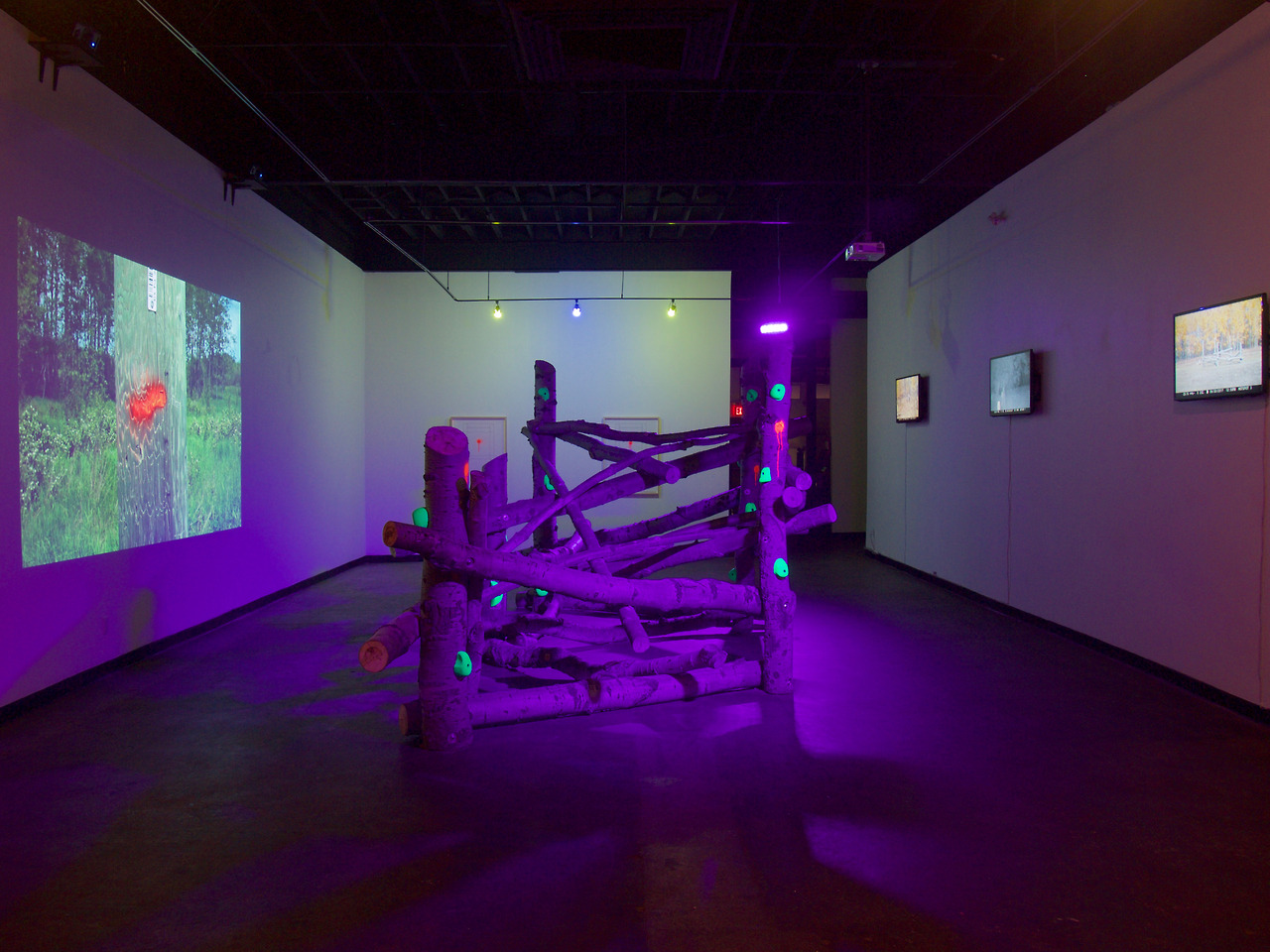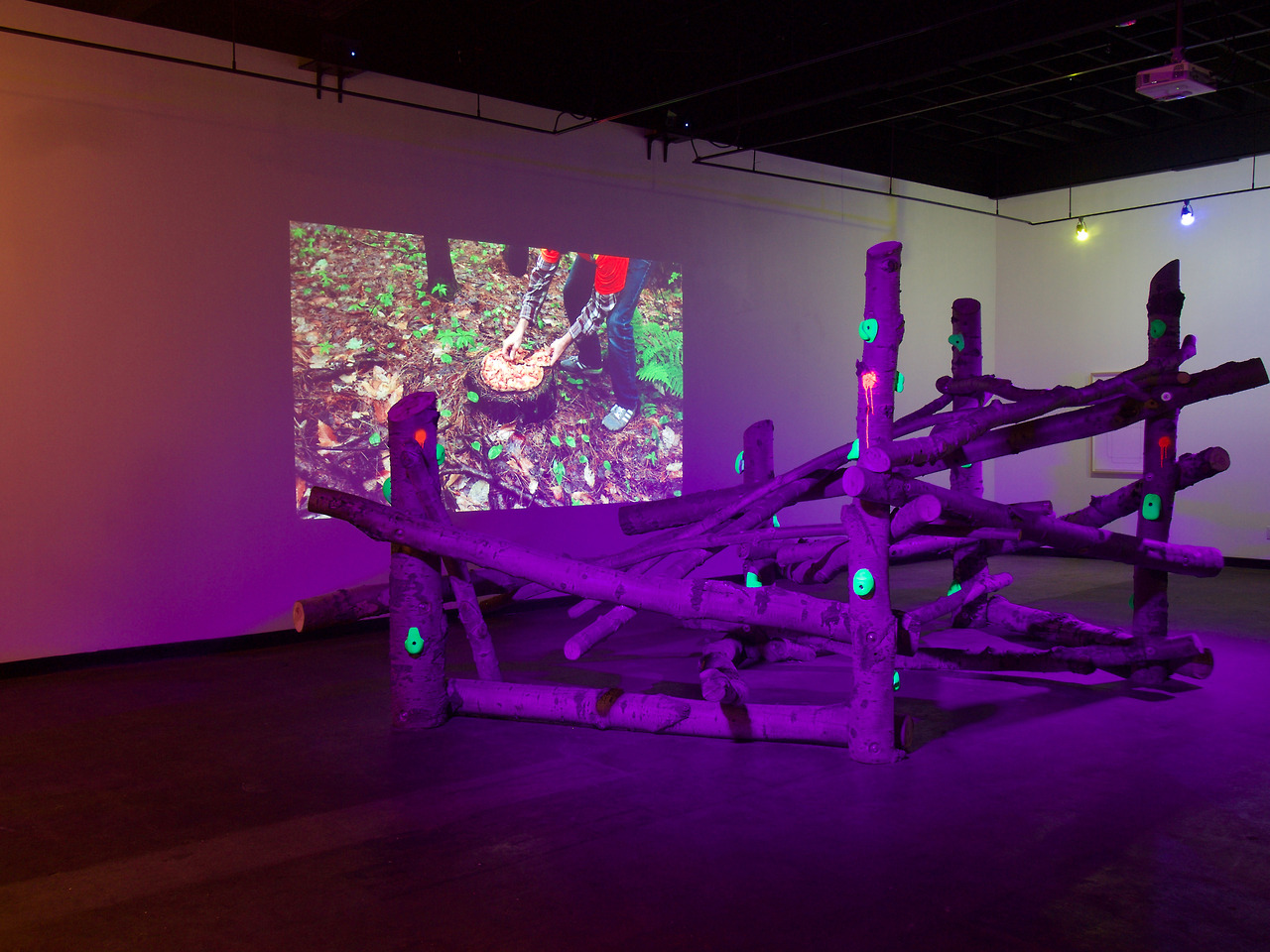Jeremy Pavka and Sean Procyk | knock on wood
October 6,–November 18, 2017
Opening reception : Friday October 6 at 7 pm
Artist Talk | Saturday, October 7 at 2pm
This collaborative exhibition by Jeremy Pavka and Sean Procyk uses sound, video, and sculpture to examine human processes of disturbance on the land. More specifically the installation considers the role that fear has played in shaping settler practices of interacting with the natural environment. Our relationship to land waivers from a resource for exploitation to an object of possession, or a matter of inquiry for preservation, comfort, and enjoyment. Through this series of multi-sensory works Sean and Jeremy explore the inconsistencies in the perception of 'land' in capital-driven North American cultures.
For Pavka and Procyk, the attitudes, folklore, and demographics that comprise Bigfoot culture, are useful in understanding the motives and emotions driving settler-based processes of disturbance. The majority of contemporary encounters with Bigfoot are reported by hunters or people working in extractive industries, in other words: those who take directly from the land. In most cases the individual had an uncanny experience in nature and the resultant affect was fear. Fear of the unknown, of vulnerability, or possibly of being illegitimate on the land.
Lethbridge independent curator and writer Christina Cuthbertson writes on knock on wood:
knock on wood is an exhibition of new work by Jeremy Pavka and Sean Procyk in which they explore states of fear, uncertainty, ambivalence, and apathy as they are enacted and represented in relation to the land. The cornerstone of this exhibition, “Big Whoop,” depicts man and myth outdoing one another in an—albeit sluggish—round of tag. Their prosaic one-upmanship evokes the slow play of a long con. Trading blow for blow with hunter-orange spray paint, they mark trees, a barn, pizza boxes, and one another. In the growing suspense and escalating mischief, it seems the colour orange may be the only winner of this play. Orange tells us what is claimed, to be extracted or demolished. Orange is a warning. Orange is a target. The sound of distant automatic gunfire overlays the metallic drone of one totally badass power chord—but is it a gun? Is it a drum? Could it be knocking? To knock on wood is to enact the superstitious ritual of warding off the evil eye, though it’s also said to be the preferred method of communication with Bigfoot.
For Pavka and Procyk, the attitudes, folklore, and demographics that comprise Bigfoot culture, are useful in understanding the motives and emotions driving settler-based processes of disturbance. The majority of contemporary encounters with Bigfoot are reported by hunters or people working in extractive industries, in other words: those who take directly from the land. In most cases the individual had an uncanny experience in nature and the resultant affect was fear. Fear of the unknown, of vulnerability, or possibly of being illegitimate on the land.
It is argued fear was the underlying emotion driving colonial expansion,1 and it is clear fear continues to influence sociopolitical development. Fake news, witch hunts, and sensational rumour are effective tactics for coping with fear, as they establish scapegoats, diverting attention from other contentious issues. It’s classic misdirection. When used by those in power it maintains status quo; when used on stage it’s way of sneaking something past the audience. For Pavka and Procyk, the use of humor, farce, and absurdity allow them to speak to sensitive issues regarding the land, while also acknowledging their own fallible positions within it.
“Big Whoop” presents two naïve and clumsy white dudes navigating land, leisure, and destruction through their lackadaisical relationship with Bigfoot. The doltish, yet likably earnest characters are hyperbolic versions of the artists themselves, making their way through physical and aesthetic interventions in the environment. With self-effacing humour, Pavka and Procyk earnestly navigate their role as artists who are deeply invested in the land. Their willingness to self-skewer, and lay themselves vulnerable, is their way of sincerely and responsibly owning the privilege they possess as a result of exploitative, and devastating histories of colonial expansion in Canada. This heightened ambivalence is echoed throughout “Big Whoop”, in their use of juxtaposition, musical dissonance, and the adversarial relationships between characters on screen.
Throughout “Big Whoop”, Pavka and Procyk subtly point to artifice, with visible microphones, a manicured lawn, and brief appearances from the artists themselves. They speak to the relationship between filmmaking and veracity, a subject of constant debate within the realm of Bigfoot footage. On the eve of the 20th anniversary of the infamous Patterson-Gimlin film, Pavka and Procyk seize a timely moment to investigate the role of footage as a tool of verification, debunking, or conviction.
In the recounting of close encounters with Bigfoot, there are hundreds of stories with striking similarities—belief is tempting. After all, consistent testimonies in a court of law would be taken as credible evidence of an event. Maybe. Maybe not. It depends on who is testifying, who is on trial, and what structures, hierarchies, or interests are at stake. It depends on whose fear is portrayed, and whose power. How do those without agency testify? How does the land speak for itself? What constitutes proof or believability? How does one deal with questions that don’t have answers? Who cares? What’s the big whoop?
Throughout their work Jeremy Pavka and Sean Procyk probe difficult questions about the state of the land and their relationship to it—they trudge through the wearisome ambivalence that often leads to paralyzing apathy, in order to engage with serious issues, while never taking themselves too seriously.




